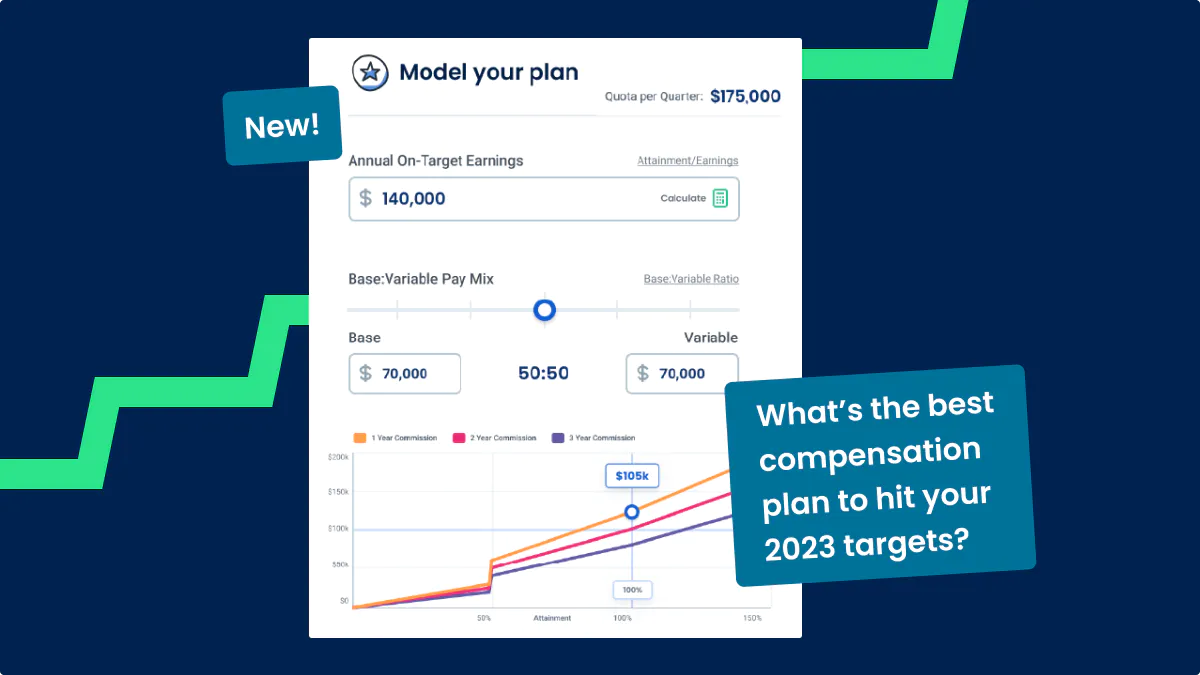This blog is the second in a four-part series featuring comp plan examples for account executives from industry leaders. To catch the first blog, featuring Liz Christo, Amy Volas, and Kevin “KD” Dorsey, check it out here.
Prior to founding RevGenius, Jared Robin sold for one of the largest transportation and shipping vendors in the world.
The company itself? Phenomenal, said Jared, while reflecting on his 7-year tenure.
But the compensation plans? Yikes.
“What makes sales compensation so hard is that people organize the plans without transparency,” said Jared. “At that company, nobody at the VP level understood how reps could get 100 percent to goal.”
That meant reps couldn’t map it out for themselves either.
“Everybody had different sized goals that combined maintaining a current book of business and net new,” Jared added. “My territory may have been $4M, while someone else at my exact level may have had a quota of $5M. Our gates were different, too.”

Compensation Hub
Discover, compare, and build compensation plans. Customize compensation models using 9 variables.
Find Compensation Plans“You’re trying to solve for a plan that the reps understand and know exactly what they need to do to make more money and why they should bring in one more deal,” Sam said.
So, instead of trying to model the perfect plan that accounts for every edge case, strive for simple, standardized plans that bring transparency and motivation.
Impact on gender pay gaps
Another setback that often goes understated when it comes to complicated, non-standardized comp plans is the pay discrepancies that unfold between men and women in sales.
Lori Richardson, Founder of WOMEN Sales Pros, Harvard Business School Sales Coach, and Growth Strategist for Score More Sales, experienced this firsthand.
“Some people are just flat-out paid differently,” Lori said. “That happened to me. I found that my male counterparts were paid more, even though they had no more experience than me.”
While Lori spoke directly to the interview and negotiation differences between men and women in sales, inconsistent, complex, non-standardized plans can also contribute to unequal pay. The more plans and mechanics across plans, the greater the risk of paying team members unfairly.
That’s why we encourage organizations to be open (and upfront) with on-target earning potential and compensation details.
“I’m a big proponent of putting salaries and compensation information publicly available on job posts,” said QuotaPath’s Chief of Staff Graham Collins. “It doesn’t make sense that every single person in a sales organization gets paid the exact same, but by putting a structure behind it that is widely understood and that commensurates the amount of money they’re earning with their quota, you’re making it fair.”
Fair plans
To save leaders from the instinctual reflex to overcomplicate plans that Sam called out, use our newest resource Compensation Hub.
This library of 15 sales commission structures enables leaders to discover, compare, customize, and share fair and standardized plans that align compensation strategies to business goals.
Each plan includes a modeler with nine customizable inputs. Leaders can experiment with different figures to run scenarios based on historical or projected data on deal sizes, annualized quota, and more. Then, once you’ve got a plan that meets your needs, share and save it with members of your team.
To get started, check out the plans Lori, Jared, and Sam put together below. Plug in your own inputs to see if they’d fit your business. And, for more commission structure templates, visit Compensation Hub.
View Lori’s plan: Single Rate Commission
Annual OTE: $160K
Base Variable Pay mix: 40:60
Jared’s comp recipe for renewals
For an easily understandable plan that guarantees renewals and pays reps more upfront, look no further than Jared’s plan.
The Commission with Contract Term Multiplier plan pays a higher commission percentage when a rep signs up a customer for more than one year. This encourages multi-year deals and rewards reps accordingly for pushing for longer terms.
A note, typically we don’t see contracts that exceed three-year terms.
View Jared’s Plan: Commission with Contract Term Multiplier
Annual OTE: $200K
Earnings Rules: 10% rate on all contracts one year or less
12.5% rate for all contracts greater than one year
Sam’s productivity plan
We see mixed reviews of decelerators, but one person who is a fan of them is Sam. His plan of choice is the Commission with Accelerators and Decelerators.
“When a rep misses their number badly, it cascades upward,” Sam said. “I think it’s pretty compelling when a 10% miss on a $20M business equates to $2M. That’s why I think having a baseline level of productivity and performance like a decelerator should be baked into the comp plan.”
Do you agree?
View Sam’s Plan: Commission with Accelerators & Decelerators
Annualized Quota: $560K
Earnings rule: 0% to 50% of quota = 5% decelerator
50% to 100% = 10% base rate
100% and above = 15% accelerator
About Compensation Hub
QuotaPath’s newest (free) resource invites Sales, RevOps, and Finance leaders to discover, compare, customize, and share compensation models. Strike the right balance between pay and performance to successfully align your compensation strategy to your business strategy.
About QuotaPath
QuotaPath provides a sales compensation and commission tracking platform for scaling GTM teams. Pairing an easy-to-use user experience with a highly technical backend, QuotaPath is the only solution fit to get Sales, RevOps, and Finance all on the same page.
To see how we fit into your tech stack, check out our integrations page. To learn more, book a time with a member of our team today.




